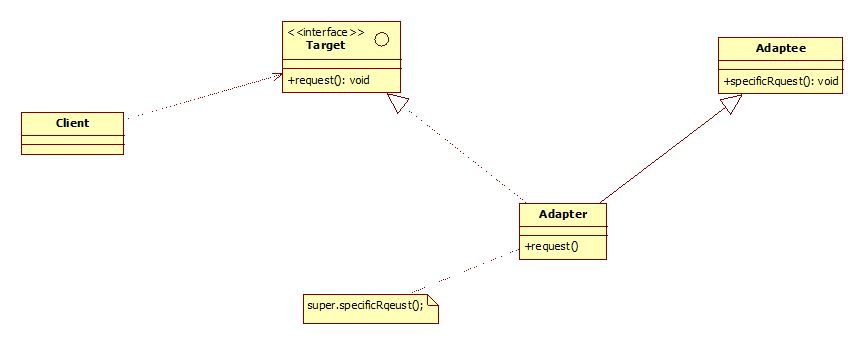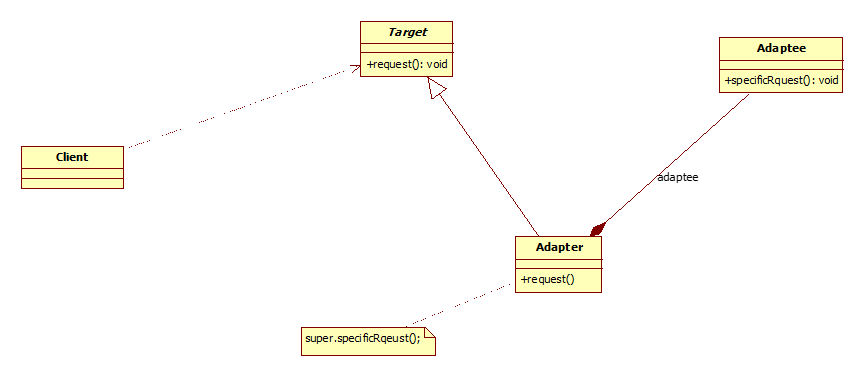1. 适配器模式动机定义
1.1 适配器模式动机
在软件开发中,存在一些不一致的情况,例如在某个加密模块中已经写好了的数据库操作类。为了提高开发效率,可以重用已有的加密算法,这些算法封装在一些第三方的类中,需要实现的是不修改现有类的基础上重用第三方加密方法。
1.2 适配器模式定义
将一个接口转换成客户希望的另一个接口,适配器模式使接口不兼容的那些类可以一起工作,其别名包装器。
2. 适配器模式结构与分析
2.1 类适配器结构

2.2 对象适配器结构

2.3 适配器模式结构
- Target(目标抽象类)
目标抽象定义客户要用特定领域的接口,可以是抽象类或者接口,也可以是具体类;在类适配器中,由于Java语句不支持多重继承,他只能是接口。(或者使用抽象类定义后用对象适配器实现)
- Adaptee(适配者类)
适配者即被适配的角色,它定义了一个已经存在的接口,这个接口需要适配。适配者类一般是一个具体的类,它包含了客户希望使用的业务方法,在某些情况下甚至没有适配者类的源码。
- Adapter(适配器类)
适配器类可调用另一个接口,作为转换器,对Adaptee和Target进行适配。
- Client(客户类)
在客户类中针对目标抽象类进行编程,调用目标抽象中定义的业务方法。
3. 类适配器
适配者类
public class Adaptee {
public void specificRequest(){
System.out.println("适配者的实现的方法!");
}
}
适配器类
public class Adapter extends Adaptee implements TargetInterface{
// 通过类适配器模式可以直接调用适配者的方法
public void request(){
System.out.print("适配器模仿:");
super.specificRequest();
}
}
目标抽象类
public interface TargetInterface {
public void request();
}
客户类
public class Client {
public static void main(String[] args) {
Adapter a = new Adapter();
a.request();
}
}
4. 对象适配器
目标抽象类
public abstract class DataOperation {
private String password;
public void setPassword(String password){
this.password = password;
}
public String getPassword(){
return this.password;
}
public abstract String doEncrypt(int key, String ps);
}
适配者类
/**
* 数据加密类
*/
public final class Caesar {
public String doEncrypt(int key, String ps){
String es = "";
for (int i = 0; i < ps.length(); i++) {
char c = ps.charAt(i);
if(c >= 'a' && c <= 'z'){
c += key % 26;
if(c > 'z') c -= 26;
if(c < 'a') c += 26;
}
if(c >= 'A' && c <= 'Z'){
c += key % 26;
if(c > 'Z') c -= 26;
if(c < 'A') c += 26;
}
es += c;
}
return es;
}
}
适配器类
/**
* 第一种加密适配器
*/
public class CipherAdapter extends DataOperation {
private Caesar caesar;
public CipherAdapter(){
caesar = new Caesar();
}
@Override
public String doEncrypt(int key, String ps) {
return caesar.doEncrypt(key, ps);
}
}
扩展新的加密算法
/**
* 新的加密算法
*/
public final class NewCipher{
public String doEncrypt(int key, String ps){
String es = "";
for (int i = 0 ; i < ps.length(); i++) {
String c = String.valueOf(ps.charAt(i) % key);
es += c;
}
return es;
}
}
新加密算法的的适配器
public class NewCipherAdapter extends DataOperation {
private NewCipher newCipher;
public NewCipherAdapter(){
newCipher = new NewCipher();
}
@Override
public String doEncrypt(int key, String ps) {
return newCipher.doEncrypt(key, ps);
}
}
客户端
/**
* 加密适配器客户端测试
*/
public class Client {
public static void main(String[] args) {
DataOperation dao = (DataOperation)XMLUtil.getClassName();
dao.setPassword("sun");
String ps = dao.getPassword();
String es = dao.doEncrypt(6, ps);
System.out.println("明文:" + ps);
System.out.println("密文:" + es);
}
}
XMLUtil
public class XMLUtil {
public static Object getClassName(){
try{
// 单例获取文档工厂对象
DocumentBuilderFactory dFactory = DocumentBuilderFactory.newInstance();
// 使用工厂对象创建构建文档对象
DocumentBuilder builder = dFactory.newDocumentBuilder();
// 文档对象
Document doc;
// 通过文档构建对象读取xml文件并创建文档对象
doc = builder.parse(new File("/workspace/demo/adapter/objAdapter/config.xml"));
// 根据节点名获取节点集
NodeList nl = doc.getElementsByTagName("className");
// 获取第一个节点集的第一个节点
Node firstChild = nl.item(0).getFirstChild();
// 获取节点对象的值去除头尾空格
String className = firstChild.getNodeValue().trim();
return Class.forName(className).getDeclaredConstructor().newInstance();
}catch (Exception e){
e.printStackTrace();
return null;
}
}
}
``
## config.xml
```xml
<?xml version="1.0"?>
<config>
<className>adapter.objAdapter.NewCipherAdapter</className>
</config>
5. 双向适配器
- 目标抽象
public interface Target {
public void request();
}
- 适配者
public interface Adaptee {
public void specificRequest();
}
- 具体目标抽象
public class ConcreteTarget implements Target {
public void request(){
System.out.println("目标抽象具体实现类 实现方法!");
}
}
- 具体适配者
public class ConcreteAdaptee implements Adaptee {
public void specificRequest(){
System.out.println("具体适配者类实现的方法!");
}
}
- 双向适配器
public class Adapter {
private Adaptee adaptee;
private Target target;
public void setAdaptee(Adaptee adaptee) {
this.adaptee = adaptee;
}
public void setTarget(Target target) {
this.target = target;
}
public void specificRequest(){
target.request();
}
public void request(){
adaptee.specificRequest();
}
}
- 客户端
public class Client {
public static void main(String[] args) {
Adapter doubleAdapter = new Adapter();
doubleAdapter.setAdaptee(new ConcreteAdaptee());
doubleAdapter.setTarget(new ConcreteTarget());
doubleAdapter.request();
doubleAdapter.specificRequest();
}
}
版权声明:本文为weixin_43629889原创文章,遵循CC 4.0 BY-SA版权协议,转载请附上原文出处链接和本声明。